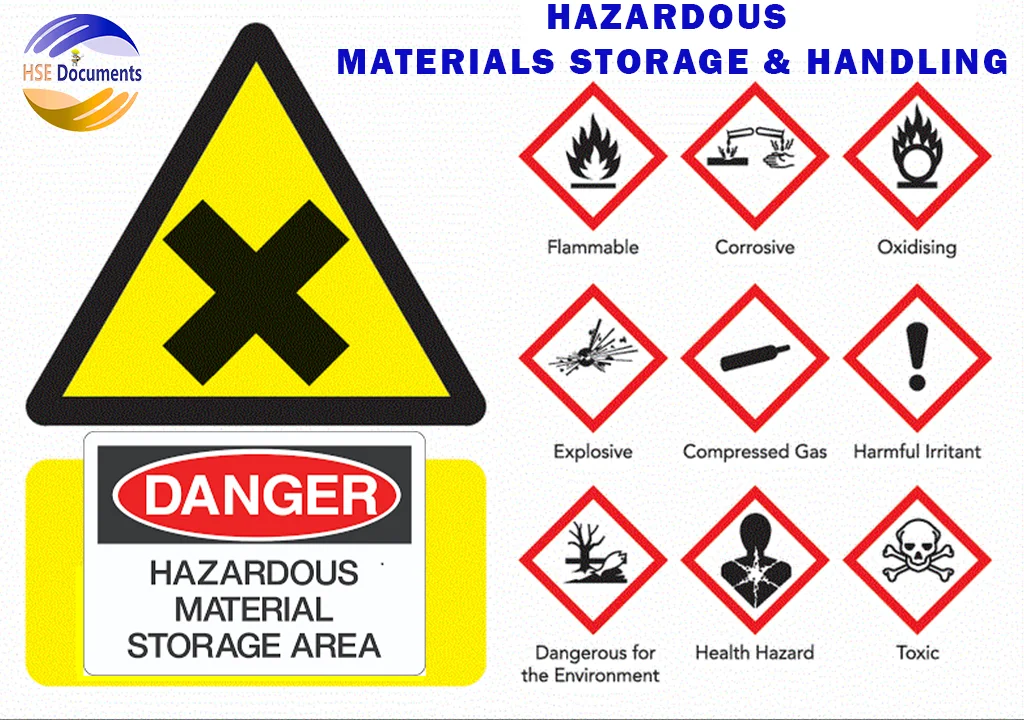Welcome to HSE
Document’s comprehensive Hazardous Materials Storage & Handling Training!
Our training program covers everything you need to know about handling
hazardous materials safely and efficiently. We focus on identifying, storing,
and disposing of hazardous substances while complying with all relevant
regulations.
Our
training begins with an in-depth understanding of hazardous materials
identification, including proper labeling, placarding, and Safety Data Sheets
(SDS). Participants will learn about the various hazard classes and categories,
such as flammable, toxic, corrosive, reactive, and radioactive substances.
We
emphasize the importance of proper storage procedures, considering factors like
compatibility, segregation, ventilation, temperature control, and containment.
Our instructors will guide you through the selection and correct use of
Personal Protective Equipment (PPE) to ensure your safety during handling.
In the
event of emergencies, our training equips you with the skills needed to respond
effectively to spills, leaks, fires, and other hazardous materials incidents.
We also cover best practices for handling and transporting hazardous materials
to prevent accidents during routine operations and transportation.
Compliance
with regulatory standards is crucial, and we keep you up-to-date with the
latest guidelines from OSHA, EPA, DOT, and other relevant authorities.
Risk
assessment and mitigation strategies are a vital part of our training to
minimize potential harm and accidents. We provide you with safety protocols and
industry best practices to maintain a secure work environment.
Join my blog site to stay updated regarding various pieces of training. Hazardous Materials Storage & Handling Training today to become well-prepared, confident, and compliant in handling hazardous materials. Keep you and your organization safe while staying ahead in this competitive market.
1. Identify and classify hazardous materials: Know the type of hazardous materials you are dealing with, as different substances have unique properties and risks. Hazardous materials are usually classified as flammable, corrosive, toxic, reactive, or radioactive.
2. Read safety data sheets (SDS): SDS provides essential information about the hazards, safe handling, storage, and emergency response procedures for each hazardous material. Always review the SDS before handling any hazardous substance.
3. Use appropriate storage containers: Store hazardous materials in containers specifically designed for their compatibility and safety. Containers should be leak-proof, tightly sealed, and made of appropriate materials to prevent chemical reactions.
4. Labeling: Clearly label all hazardous material containers with the correct identification and hazard symbols. Labels should be legible, durable, and easy to understand.
5. Storage location: Choose a designated, well-ventilated area for hazardous material storage. Keep them away from incompatible substances, sources of heat, direct sunlight, and ignition sources.
6. Segregation: Separate incompatible hazardous materials to prevent accidental reactions. Segregation is especially crucial for chemicals that may release toxic gases or become highly reactive when mixed.
7. Fire safety: Store flammable materials in designated fire-resistant cabinets or areas with appropriate fire suppression equipment. Implement fire prevention measures, such as keeping flammable materials away from sources of ignition.
8. Personal protective equipment (PPE): Provide and require the use of appropriate PPE for handling hazardous materials. This may include gloves, goggles, respirators, aprons, and other protective gear.
9. Training: Ensure that all personnel involved in handling hazardous materials receive proper training. Training should cover the specific hazards of each material, safe handling practices, and emergency procedures.
10. Emergency response: Develop and practice an emergency response plan in case of spills, leaks, or accidents involving hazardous materials. This plan should include evacuation procedures, first aid measures, and communication protocols.
11. Disposal: Follow proper procedures for the disposal of hazardous materials. Never dispose of them down drains or in regular waste bins. Contact a licensed dangerous waste disposal service for safe and compliant disposal.
12. Regular inspections: Conduct regular inspections of storage areas and containers to check for leaks, damage, or deterioration. Replace or repair damaged containers promptly.
13. Spill containment: Have spill containment kits readily available in areas where hazardous materials are handled or stored. Train employees on how to use these kits safely and effectively.









No comments:
Post a Comment